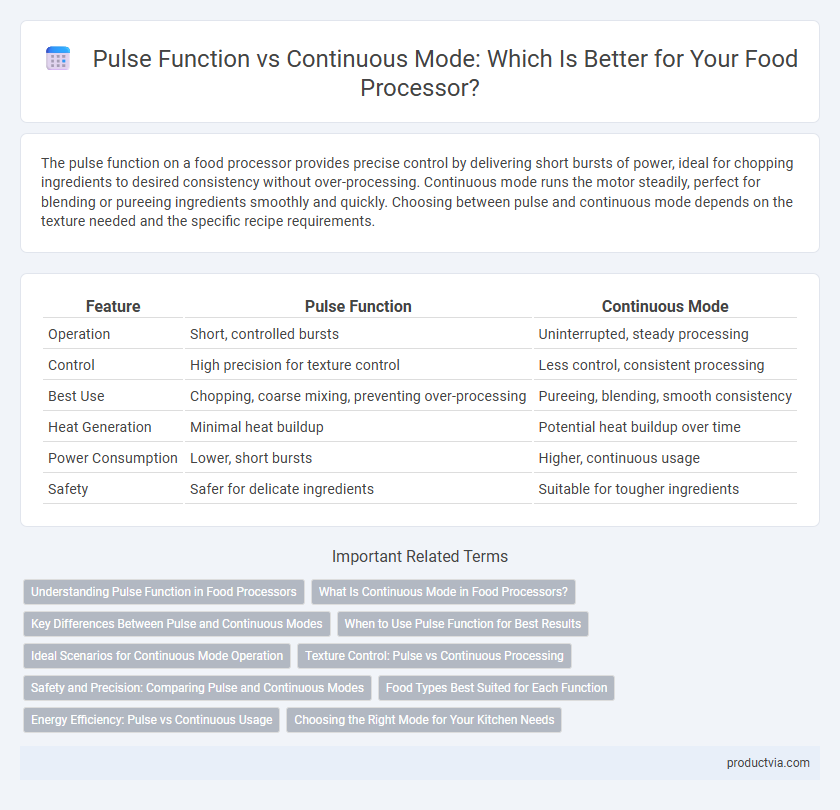The pulse function on a food processor provides precise control by delivering short bursts of power, ideal for chopping ingredients to desired consistency without over-processing. Continuous mode runs the motor steadily, perfect for blending or pureeing ingredients smoothly and quickly. Choosing between pulse and continuous mode depends on the texture needed and the specific recipe requirements.
Table of Comparison
| Feature | Pulse Function | Continuous Mode |
|---|---|---|
| Operation | Short, controlled bursts | Uninterrupted, steady processing |
| Control | High precision for texture control | Less control, consistent processing |
| Best Use | Chopping, coarse mixing, preventing over-processing | Pureeing, blending, smooth consistency |
| Heat Generation | Minimal heat buildup | Potential heat buildup over time |
| Power Consumption | Lower, short bursts | Higher, continuous usage |
| Safety | Safer for delicate ingredients | Suitable for tougher ingredients |
Understanding Pulse Function in Food Processors
The pulse function in food processors delivers short bursts of power, allowing precise control over food texture and preventing over-processing. Unlike continuous mode, which runs the blades nonstop, the pulse function helps in achieving coarse chopping, mixing, or blending with exact timing. This feature is essential for tasks requiring intermittent processing to maintain desired consistency.
What Is Continuous Mode in Food Processors?
Continuous mode in food processors allows the motor to run steadily without interruption, enabling consistent processing of ingredients for tasks like pureeing, mixing, or chopping. This setting is ideal for handling larger batches or ingredients that require uniform texture, ensuring even blending throughout. Unlike pulse function, continuous mode maintains constant motor speed until manually stopped, providing smoother results for recipes demanding thorough processing.
Key Differences Between Pulse and Continuous Modes
The pulse function in a food processor delivers short bursts of power, allowing precise control over chopping, mixing, or blending to achieve the desired texture without over-processing. Continuous mode operates at a constant speed, ideal for thoroughly blending or pureeing ingredients but can lead to over-processing if not monitored. Key differences include control level, processing precision, and application suitability, with pulse mode preferred for coarse textures and continuous mode for smooth results.
When to Use Pulse Function for Best Results
The Pulse function in a food processor is ideal for controlled chopping and preventing over-processing, especially when working with delicate ingredients like nuts, herbs, or vegetables that require a coarse texture. Using short bursts allows precise control over the consistency, making it perfect for salsa, chunky dips, or when you need to maintain the integrity of the ingredients. Continuous mode is better suited for uniform purees or dough mixing but risks turning ingredients into a paste if used without careful timing.
Ideal Scenarios for Continuous Mode Operation
Continuous mode in food processors is ideal for tasks requiring uniform blending or pureeing of ingredients, such as making smooth soups, sauces, or hummus. It ensures consistent texture by maintaining steady blade movement, which is essential for emulsifying dressings or evenly chopping vegetables for large batches. This mode is preferred when a prolonged, uninterrupted processing cycle is needed to achieve the desired culinary result efficiently.
Texture Control: Pulse vs Continuous Processing
The pulse function in a food processor provides precise texture control by allowing short bursts of power to finely chop or mix ingredients without over-processing, ideal for recipes requiring a coarser consistency. Continuous mode runs the blades non-stop for smoother blends and purees, suitable for tasks where uniform texture is desired. Choosing between pulse and continuous mode depends on the specific texture requirements, as pulse offers granular control while continuous mode ensures uniformity.
Safety and Precision: Comparing Pulse and Continuous Modes
The Pulse function on a food processor offers enhanced safety by giving users precise control over chopping intervals, reducing the risk of over-processing or overheating. Continuous mode operates at a steady speed, ideal for uniform blending, but requires careful monitoring to avoid accidents or ingredient over-processing. Choosing Pulse mode improves precision and safety, especially for delicate chopping tasks where controlled bursts prevent damage to both ingredients and the appliance.
Food Types Best Suited for Each Function
The Pulse function in a food processor excels at handling tasks like chopping nuts, coarsely shredding cheese, or creating chunky salsa, where precise control and texture variation are essential. Continuous mode is ideal for pureeing soft vegetables, blending soups, or making smooth dough, providing consistent power for uniform results. Use Pulse for delicate ingredients that require intermittent processing and Continuous for ingredients needing thorough, uninterrupted blending.
Energy Efficiency: Pulse vs Continuous Usage
The Pulse function in food processors offers superior energy efficiency by operating in short bursts, reducing power consumption compared to the Continuous mode, which runs the motor non-stop. Using Pulse mode prevents overheating and extends the motor's lifespan by limiting excessive energy use during processing tasks. Continuous mode may be necessary for certain recipes but generally consumes more electricity, making Pulse the preferable option for conserving energy.
Choosing the Right Mode for Your Kitchen Needs
The Pulse function in a food processor provides short, controlled bursts of power, ideal for chopping ingredients to a desired texture without over-processing, while Continuous mode runs the blades non-stop for thorough blending and pureeing. Choosing the right mode depends on the recipe requirements and ingredient delicacy; Pulse is perfect for precise chopping of nuts or vegetables, whereas Continuous mode excels for making smooth sauces or dough. Understanding these modes enhances kitchen efficiency, ensuring optimal texture and consistency tailored to specific culinary tasks.
Pulse function vs Continuous mode for food processor Infographic

 productvia.com
productvia.com